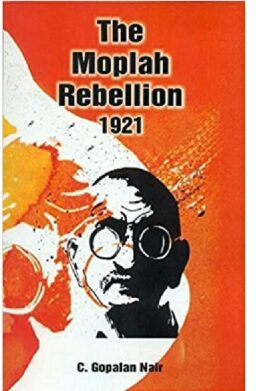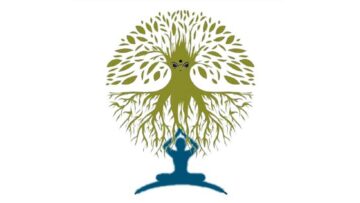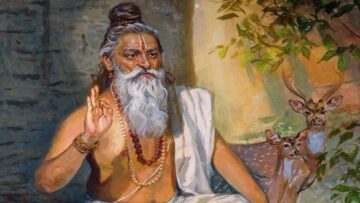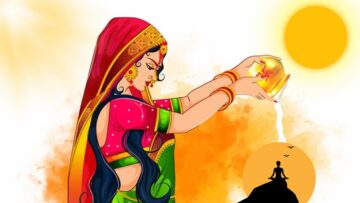Growing up, we did not know anything about the Moplah riots. If it was there in our textbooks at all, it was perhaps only a footnote to the Khilafat movement, which the Muslims in India fought for reestablishing Caliphate (Khilafat) in Turkey, which seemed like such an absurdly disconnected and irrelevant issue. Consequently, the details of the horrific Hindu genocide during the Moplah Rebellion of 1921 were utterly obscured from our collective consciousness.
To understand what really happened during the Moplah rebellion, I started looking through the literature that has only recently become available to us. It was startling to see tweets about Moplah “freedom fighters” who continued to receive pensions for participating in acts of genocide against Hindus even after freedom.
Vikram Sampath’s two-volume biography of Savarkar offered further insights into the Moplah rebellion. After succinctly summarizing the horrors of Malabar, Dr. Sampath sums up the reaction of the national leadership. Gandhi actually took the side of the ‘brave God-fearing Moplahs’ and advised Hindus to find the causes of Moplah fanaticism. He further blamed the Hindus for being uncaring towards Moplahs. His allies, the Khilafatists, congratulated the Moplahs for their heroism. Muslim League supported the Moplah carnage as a religious war accusing the Hindus of being in cahoots with the British. When Gandhi could not justify his stand after the details of the horrendous Hindu genocide came to light, Congress passed a resolution mildly admonishing the Moplahs, minimizing the scale and impact of the carnage.
Ambedkar soundly criticized Gandhi’s silence over Moplah atrocities and for victim shaming Hindus. Savarkar ‘strongly condemned the barbarity of the Moplahs and the pusillanimity with which the Congress reacted to this, just to save the Khilafat movement.’
The Moplah Rebellion, 1921, is a detailed and unbiased account of the horrors of Malabar written by Diwan Bahadur C. Gopalan Nair, the then retired Deputy Collector from Calicut, published in 1923. As the author himself says, it is a chronicle of events based on the news reports and articles published in the Madras Mail, the West Coast Spectator, and the West Coast Reformer. His analysis of the events is even-handed and unemotional.
Gopalan Nair talks about Kerala as the land of Parasurama, who peopled it with Nambudiri Brahmins and settled them in 64 villages along the coast. Later, the Nambudiris found it difficult to manage the administration and brought in Military Governors called Perumal from the adjoining states. A succession of Perumals governed Kerala. Cheraman Perumal was the last.
“The Zamorin of Calicut, one of the chief patrons of Arab trade, definitely encouraged conversion to man the Arab Ships on which he depended for his aggrandizement and decreed that, in every family of fishermen, one or more boys should be brought up as a Muhammadan.” (District Gazetteer). These were the Moplahs.
Invasion of Malabar (1766 – 1792)
Malabar comprises of the present-day districts of Kannur, Kozhikode, Wayanad, Malappuram, and Palakkad.
Hyder Ali attacked Malabar in 1766 and defeated the kingdoms of Kolathunad, Kottayam, Kadatanad, Calicut (Kozhikode,) Valluvanad, and Palaghat, who were feuding with each other. Hyder Ali wanted to capture the vast treasuries of Malabar kings and their spice trade. He managed to hold Malabar for a while though it was fiercely contested. He forced Cochin to pay tribute, but Travancore allied itself with the British and refused to pay tribute.
The Nairs, the traditional warrior class of the Malabar kings, were defeated after putting up a desperate fight against Hyder, who ruthlessly killed the Nair soldiers and deported a large contingent of war prisoners to coastal Karnataka. Only a tiny fraction of those deported survived.
After Hyder Ali, his son, Tipu Sultan, continued to oppress Malabar. With Tipu’s defeat in the Third Anglo-Mysore War, Malabar came under the control of the East India Company.
The Atrocities
C Gopalan Nair writes about the period of Kalapam (chaos) of the Mysore Conquest (1766-1792) of Malabar. During that period, there were calamitous events of forcible conversions, rape, and pillage. According to some estimates, almost a quarter of the Nair population in Malabar was murdered during Tipu’s invasion.
Nair chronicles instances of Zamorin immolating himself, unable to withstand Hyder’s torture, an entire army of 2000 Nairs of Kadathanad and hundreds of Nilambur Nambudiris getting converted by Tipu at sword point.
Tipu repeatedly vowed that he would ‘honor the whole of Malabar with Islam.’ The surviving kings, the Nambudiris, and the Nairs of Chirakkal (Kolathiri), Calicut (Zamorin), Punnathoor, Nilamboor, Kavalapara, and AzhvancheryThamprakkal, fled to Travancore, ‘the haven of refuge during that dreadful period,’ with whatever personal and temple-wealth of their dominions they could gather, seeking protection from Tipu.
With the help of Kannur Muslims, Hyder ordered his army to butcher everyone they came across. The areas through which the Mysore troops marched became devoid of human life. Dead bodies lay scattered everywhere for miles on end. Smoke from torched houses filled the skies. Every temple was pillaged and burned. A long list of temples thus destroyed is given by Tirur Dinesh in the book,Moplah Riots. In his Malabar Manual, William Logan records that even women and children were not spared.
Thus the Moplah numbers increased due to forcible conversions.
Between 1792 – 1921
After the British defeated Tipu, Malabar came under direct British rule. Cochin and Travancore continued as princely states. The Moplahs continued to foment trouble. C Gopalan Nair has listed 51 separate revolts between 1821 and 1921[1].
Breakdown of the traditional ecosystem
Before the Mysore conquest of Malabar, the Nair chieftains and Namboodiri (priests) were given hereditary land grants by the rulers. The land grant holders were referred to as Jenmis. The land, in turn, was leased to Thiyyas and Mappilas. They cultivated the land in return for a third to half of the net produce (after paying the other stakeholders of the village like carpenters, goldsmiths, agricultural laborers, and others.)
After the bloody invasions and subsequent defeat of Malabar, the Jenmis fled their lands. Tipu entered into a new accord with the leaseholders of the land, mainly Moplahs, who were, for the most part, proselytes from the Hindu population, especially lower castes.
However, within five years, the British East India Company defeated Tipu and introduced absolute property rights into the existing legal system of Malabar. The British recognized the Jenmis as absolute owners of their holding, and they were free to negotiate with the cultivators. The Moplahs felt at a disadvantage, and this sharpened their hatred towards the Hindus and British.
Before the Muslim invasion, the kings and chieftains in Malabar, supported by their armed Nair retainers, maintained law and order. The system broke down when Malabar was defeated. Tipu’s brutal methods of obtaining converts to Islam drove the Rajas and thousands of their principal adherents out of their country, broke up the social organism, and engendered a fierce and abiding hatred between Hindus and Muslims. When the British took over Malabar in 1792, this mutual animosity was at a flashpoint, and the foundations of law and order had been undermined. In particular, South Malabar was terrorized by bands of marauding Moplahs who found a secure retreat in the jungles of Ernad and Walluvanad. After the British first took over, the military assisted in peacekeeping but was gradually drafted out for fighting campaigns against Tipu until the fall of Srirangapatam. By the end of the 18th century, the Malabar district was divided into Collectorates, and even though a regular police force was established, police duties were discharged by the ordinary revenue peon for the most part. By 1823, the peons were too busy with the revenue survey for police duty. The violent Moplah outbreaks, which began in 1856, soon revealed the inadequacy of the system. The ease with which the collector of Malabar, Connelly, was killed in 1856 underscored the utter inefficiency of the Police.
Logan quotes T. L. Strange, Special Commissioner in Malabar investigating Moplah outrages, in his Malabar Manual. Strange says not a single instance of an outbreak could be attributed to the oppression of tenants by landlords and directly accuses the Moplah tenantry of evading their obligations and resorting to false and litigious pleas, especially in South Malabar[2].
Khilafat Movement
The Ottoman Empire fell after the First World War. The Muslims in British India wanted to ensure the survival of the Caliphate (Khilafat.) They started a political movement to influence the British to restore the Caliph, the leader of the Muslims, back to his original authority. The leaders of the Khilafat movement, Shaukat Ali, Mohammad Ali, and Maulana Abul Kalam Azad, formed an alliance with the Indian National Congress, the largest political party in India, and the nationalist movement in 1920. Gandhi and the Khilafat leaders promised to work and fight together for the causes of Khilafat and Swaraj.
The Khilafat movement was introduced into the district of Malabar on 28th April 1920 by a resolution at the Malabar District Conference, held at Manjeri, the headquarters of Ernad Taluk. Gandhi and Shaukat Ali visited Calicut on 18th August 1920. ‘The object of the Congress was the attainment of Swaraj by legitimate and peaceful means. The policy of the Khilafat was progressive non-co-operation with the Government to settle the Turkish question following the just and legitimate sentiments of the Indian Moslems. With that, several Khilafat Committees were established in Malabar. The Moplahs, thoroughly agreeable to the idea of Swaraj, knew full well that, but for the interference of the British between them and the Hindus, a Moslem Swaraj would soon be a fait accompli. Now that the Hindus had also joined them, the accomplishment of the object was easy enough by violence.[3]’
“Though the Khilafat was a movement against the British, several past grievances got fused into the volatility of the situation. Weapons were organized, and preparations made to declare the coming of the Islamic Kingdom. One Khilafat leader, Ali Musaliar, was proclaimed the raja, Khilafat flags were raised, and Ernad and Walluvanad were declared Khilafat kingdoms.[4]”
The association with INC and Gandhi lent respectability to the rioting and brutal violence displayed by the Moplahs. Several acts of defiance were led by Ali Musaliar. The Moplahs got the opportunity to assert themselves when the police searched the house of V. Mohammad, the local Khilafat secretary, for a gun supposedly stolen from the Nilambur Tirumulpads. And the rioting started.
The Moplah rebellion of Malabar in August 1921 was a tragic offshoot of the Khilafat movement. Already given to frequent violent outbreaks, Moplahs were driven by a toxic cocktail of poverty, lack of education, and virulent religious fanaticism fomented by the Khilafat preachers and Mullahs. The denouement was the blood-curdling atrocities committed by them during the Moplah rebellion.
Hindus were tortured, raped, looted, and killed. Horrifying instances of them being flayed, skinned alive, being forced to dig their own graves, children snatched from the arms of parents and killed, and women driven out of their homes to wander around in forests naked, hungry, and thirsty have been recorded.
The Moplah rebels attacked government offices, subtreasuries, and homes, carrying away everything they could lay their hands upon. They burned and destroyed thousands of homes, public buildings, and temples to ashes and murdered everyone they encountered. Sufficient Government forces were not available until the 28th to cope with the situation.
Gopalan Nair has paid tribute to Captain P. McEnroy and his small force of 125 Leinsters and the special police on 26th August 1921, who, on their way to relieve Mallapuram, fought a pitched battle lasting five hours with 4000 Moplah inflicting 400 casualties. He says this saved Ernad Hindus because the Moplahs had planned to drag all the Hindus in Manjeri and surrounding villages into the Mosques and convert them to Islam the same day, Friday, after the Jama prayer. Caps, dresses, and jackets were all ready for distribution among the converts. But the idea of wholesale conversion was abandoned in consequence of the Pookotur Battle.
The British soldiers surrounded Kizhekkepalli Mosque in Tirurangadi, held by the rebels. After a pitched battle, several Moplah soldiers were killed. The survivors, Ali Musaliar and other rebel leaders, surrendered, and a stash of weapons were recovered. The capture of Ali Musaliar ended the first act of the drama.
The military operations would continue till the end of January 1922. Battalions of Chin Kachins, Gharwalis, Gurkhas, and special police forces were deployed to break up or neutralize Moplah bands. The capture of the ‘Khilafat King,’ Varian KunnathKunhamad Haji, marked the final collapse of the rebellion.
I found a very interesting insight in Rajeev Srinivasan’s blog, Shadow Warrior. He quotes Beyond Rampage: West Asian Contacts of Malabar and the Khilafat, a book written by Dr Hari Shankar, an archaeologist and scholar, who argues that the riot was instigated by wealthy Muslim traders looking to expand their monopoly over the sea-borne timber trade to the Middle East and Turkey from the Nilambur forests, where the lands were owned by the temples.
Relief Measures
The Zamorin Raja of Calicut spoke in a conference held at Calicut on 19 February 1923 and gratefully acknowledged the invaluable assistance rendered by Mr. G. K. Devadhar of the Servants of India Society and the volunteers who came with him.
By October 1921, the Arya Samaj Society deputed Pandit Rishi Ram[5] to visit Malabar to render relief to the distressed refugees and the reconversion of Hindus who had been forcibly converted to the Muslim faith.
The Arya Samaj raised substantial funds for relief work and reconversion of forced converts till September 1922. Except for small donations from local persons, this money came from Punjab and other places outside Madras Presidency.
The Shuddhi Movement
A meeting was held on 20 August 1922, under the presidency of the Zamorin Raja with a council of Nambudiri Vaideekans, attended by several prominent people and Mr. R H. Ellis, I C S, Collector of Malabar, to decide the future status of a large number of forced converts. They resolved to reconvert the Hindus forcibly converted to Islam during the Moplah rebellion.
The Arya Samaj Society sent Arya Missionary Pandit Rishi Ram to Calicut, and he, in addition to giving relief to the refugees, took steps to effect reconversion of forced converts.
“When the rebellion subsided, Arya Samaj workers proceeded to the rebel area and gave relief to those converted families who were still keeping back under the fear of rebels. They were brought to Calicut and other safe places and readmitted into Hinduism. When orthodox people had objections about giving equal treatment to the readmitted persons, the Samaj workers were sent to explain matters and persuade the people to treat them as their brethren as before the rebellion! Happily, almost all the forced converts, except for a few stray cases, were restored to Hinduism, who otherwise would have continued as Moplahs or formed some outcaste sections.[6]”
Gopalan Nair gratefully acknowledges the work of the Arya Samaj in Malabar as unique and declares Hindu Malabar will forever be grateful to them and its representative Pandit Rishi Ram. Since forcible conversions began with the Mysore conquest, they had found it impossible to effect reconversion. A section of Nairs in Malabar whose ancestors were forcibly converted during the time of Tipu relapsed to Hinduism after his departure. But they have not managed to integrate with the other Nairs and remain a separate section known as ‘Chela Nayars.’ The converts had given up hope, and to their great relief, the Arya Samaj succeeded in welcoming them back into the Hindu fold.”
Still, unfortunately, the concession was not made applicable to the solitary Brahmin convert.
The Aftermath
On 23 December 1926, Swami Shraddhanand, the leader of the Arya Samaj, who had led the Shuddhi movement, was killed by an assassin, Abdul Rashid. Gandhi referred to the killer as ‘dear brother’ and advised Hindus to remain peaceful and refrain from seeking revenge for the murder.
After reading Savarkar’s hard-hitting and gut-wrenching novel, ‘The Moplah,’ I wanted to know the ‘real’ cast of characters and the historical background of the Moplah riots. Gopalan Nair’s book was an eye-opener. While he is studiously dispassionate, his own distress at watching the terrible genocide at close quarters comes through when he says that “the Hindus and the Moslems will recognize the necessity of mutual toleration, if not amity, and work together for the restoration of happiness and prosperity to their beloved Motherland, the Land of Kerala.” He thanks Capt. McEnroy for saving the Hindus of Ernad. This is an invaluable book that offers a lot of contemporary information about the riots.
This book must be read to know the true history of Malabar, especially after a hundred years of determined effort at whitewashing the horrors of the Hindu genocide and sweeping it under the carpet. If we do not study history, we will run the risk of repeating it.
References:
- Vikram Sampath, Savarkar, Echoes from a Forgotten Past, 1883 – 1924
- C Gopalan Nair, The Moplah Rebellion, 1921
- https://aryasamajkerala.org.in/
- TirurDinesh, The Moplah Riots
- https://twitter.com/Janamejayan/status/1131390618406707200?s=20
- https://twitter.com/Janamejayan/status/1131390621799845890?s=20
- 43: All those anniversaries, but they all may boil down to the powerful screwing the meek – by Prof. Rajeev Srinivasan – Shadow Warrior (substack.com)
[1]Appendix I, Past Moplah Outrages, C Gopalan Nair, The Moplah Riot, 1921.
[2]Manual of the Malabar District : Logan, William, p.614
[3]C Gopalan Nair, The Moplah Rebellion, 1921
[4]Vikram Sampath, Savarkar, Echoes from a Forgotten Past, 1883 – 1924
[5]PANDIT RISHIRAM (1893 – 1970) – Arya Samajam Kerala
[6]From Pandit Rishi Ram’s Letter
Disclaimer: The opinions expressed in this article belong to the author. Indic Today is neither responsible nor liable for the accuracy, completeness, suitability, or validity of any information in the article.











